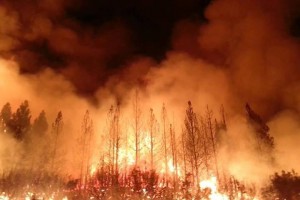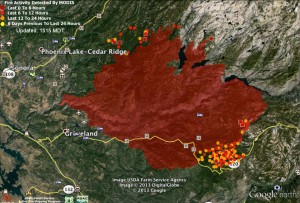The Rim Fire Incident Command has released the following “Fact Sheet” for the fire:
Rim Fire: Day 17
Acreage: 235,841
Square miles: 371
Largest wildfire in the United States to date in 2013
(Second largest to date in 2013: Lime Hills Fire, Alaska 201,809 acres)
No. 1-ranked on national wild land firefighting priority list
Fourth largest California wildfire in historical records dating to 1932
(The four largest California wildfires have all occurred since 2003)
Personnel currently on incident: 4,185
States that have sent firefighters or other personnel: 44 and the District of Columbia
Cal Fire geographical units that have sent personnel: 20 of 21
Inmate personnel from the California Department of Corrections and Rehabilitation: 746
Proportion of inmate personnel working on the fire: 17.1 percent
Completed containment line: 110.7 miles
Completed dozer line: 149.7 miles
Hand line: 9.3 miles
Road Used as Line: 19.9 miles
Total acres burned in California to date in 2013:
493,627
Rim Fire acres as a proportion of burned acres in California:
47.8 percent
Total aviation hours: 1,543
Water dropped: 2.0 million gallons
Fire retardant dropped: 2.3 million gallons
Acreage in Yosemite National Park: 66,155
Proportion of the fire burning in Yosemite National Park: 28 percent
Proportion of Yosemite National Park within the fire perimeter: 8.7 percent
Size of the fire area:
More than five times the size of Washington, D.C.
Hot meals served:
Breakfasts: 45,133 Dinners: 41,558
Pounds of firefighter laundry washed:
14,148.3
Origin of Rim Fire name: The fire started near a scenic overlook in Stanislaus National Forest called “Rim of the World”
Rim Fire didn’t have to happen by JBB The EARTH STORY
This image shows old, tall trees in the Yosemite area at the mercy of the Rim Fire. Although that fire is finally approaching the point of being under control, it will leave a legacy that needs to be dealt with for a long time. The worst part of that legacy is that the fire did not need to happen.
As many have pointed out, fire can be a healthy thing in the American west. Many plants are able to germinate after fires pass through, and fires clear out underbrush allowing the forests to regrow. That’s the kind of fire these areas need.
However, the rim fire was something else, as illustrated by this photo; the rim fire is a fire type known as a crown fire, a fire that burns trees all the way to the top. A normal fire regenerates the forest but spares many of the trees by burning underneath them; a crown fire is an out of control blaze which is so hot and so large that it kills the trees by burning all the way to the top. In the case of a crown fire, it can take years to decades for forests to recover while a normal brush fire is a small event that actually makes the forest stronger.
A crown fire is a forest-killer. It’s the kind of fire you want to avoid, and it’s the kind of fire we’ve seen in the last few weeks. The Rim Fire has now burned almost a thousand square kilometers of area (368 square miles, 235,000 acres) and in the next few days will probably become the 3rd largest wildfire by area in California history. It burned all the way up to the south shore of the Hetch Hetchy reservoir and will leave a scar on the northern fringes of Yosemite National Park that will take years to heal.
Perhaps the saddest part of this story was published last weekend. This fire, at least this enormous forest-killer didn’t need to happen.
The U.S. government used to fund significant efforts to prevent wildfires; clearing brush and setting small fires in areas so that large, out-of-control blazes would be less likely. But, the budget for that program has been hacked by nearly 50% over the past couple years and will likely be cut even further this year to pay for firefighting.
In 2012, the U.S. Forest Service approved a plan to clear brush and burn controlled areas over 65 square kilometers (25 square miles, ~9000 acres) in the Stanislaus National Forest just outside of Yosemite. The 8 sites that were selected were some of the exact areas that burned early in this fire and helped it grow completely out of control.
Previous experiences in California have shown that these fire control efforts work. There have been several historic examples of large fires burning up to the boundary of an area cleared of brush a few years earlier and stopping almost right at that boundary because the fuel is used up beyond that point.
Those projects were approved in 2012 by the Forest Service but they never happened. There simply wasn’t enough money to do it. The last several years the firefighting budget at the federal level has been insufficient to cover the costs of fighting fires out west, and the money to finish the year has come from shutting down prevention efforts.
If that does not seem like an intelligent application of resources, the Rim Fire should be your proof. So far, the Rim Fire has cost over $70 million to fight. The current estimate suggests this fire will be contained by September 20, so there are weeks of firefighting still left; this fire may well cost $100 million to fight.
For comparison, the cut in fire prevention funding from the U.S. Federal Government from 2012 to 2013 was $208 million. The money spent fighting this one fire is already 1/3 of the amount cut from the fire prevention program over the last year, and it has burned through areas that should have been cleared but weren’t.
This fire shouldn’t have happened. The Forest Service wanted to do their job, but there is no money to prevent fires, only to fight them, despite the fact that preventing them is cheaper and helps avoid the formation of crown fires that can devastate a forest.
-JBB
Financial state of firefighting:
Image credit: NASA/Earth Observatory
*****
This map shows active fires on the north side which is said to be ‘part of a burning operation that will take place for several
days. There is a large area of unburned fuel between the edge of the fire and the completed containment line that needs to be dealt with.’ Lisa Askew GROVELAND

